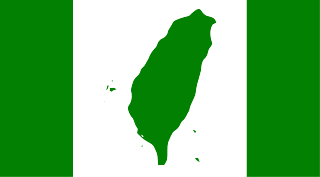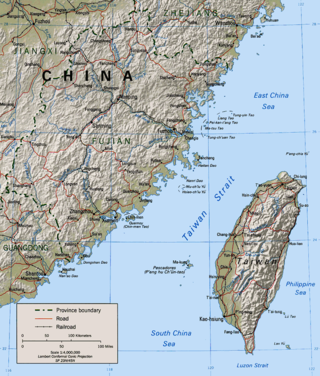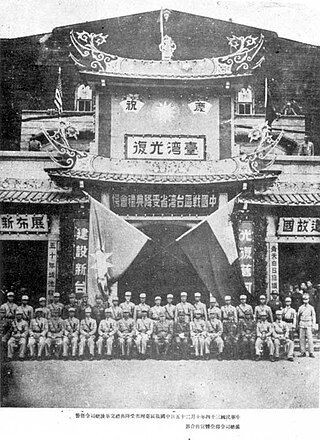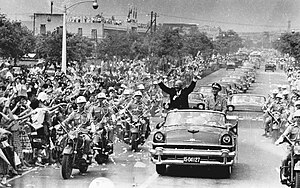
The Taiwan independence movement is a political movement which advocates the formal declaration of an independent and sovereign Taiwanese state, as opposed to Chinese unification or the status quo in Cross-Strait relations.

The Taiwan Relations Act is an act of the United States Congress. Since the formal recognition of the People's Republic of China, the Act has defined the officially substantial but non-diplomatic relations between the US and Taiwan.
The political status of Taiwan or the Taiwan issue is a long-running dispute on the status of Taiwan, currently controlled by the Republic of China (ROC). Originally based in Mainland China, the ROC government retreated to Taiwan in 1949 after the Chinese Communist Party (CCP) won the Chinese Civil War and established the People's Republic of China (PRC) in Mainland China. Since then, the effective jurisdiction of the ROC has since been limited to Taiwan, Penghu, Kinmen, Matsu, and smaller islands.
The term One China may refer, in alphabetical order, to one of the following:

The Taiwan Strait is a 180-kilometer -wide strait separating the island of Taiwan and continental Asia. The strait is part of the South China Sea and connects to the East China Sea to the north. The narrowest part is 130 km wide.

The Treaty of San Francisco, also called the Treaty of Peace with Japan, re-established peaceful relations between Japan and the Allied Powers on behalf of the United Nations by ending the legal state of war and providing for redress for hostile actions up to and including World War II. It was signed by 49 nations on 8 September 1951, in San Francisco, California, at the War Memorial Opera House. Italy and China were not invited, the latter due to disagreements on whether the Republic of China or the People's Republic of China represented the Chinese people. Korea was also not invited due to a similar disagreement on whether South Korea or North Korea represented the Korean people.

The Joint Communiqué of the United States of America and the People's Republic of China, also known as the Shanghai Communiqué (1972), was a diplomatic document issued by the United States of America and the People's Republic of China on February 27, 1972, on the last evening of President Richard Nixon's visit to China.

The Sino-Japanese Peace Treaty, formally the Treaty of Peace between the Republic of China and Japan and commonly known as the Treaty of Taipei, was a peace treaty between Japan and the Republic of China (ROC) signed in Taipei, Taiwan on 28 April 1952, and took effect on August 5 the same year, marking the formal end of the Second Sino-Japanese War (1937–1945).

The Taiwan Security Enhancement Act was a US Congressional bill which never became law. It was passed by one of the Houses of the U.S. Congress, the House of Representatives, on February 1, 2000, by a vote of 341 to 70. It envisaged greater United States military support of the Republic of China/Taiwan, including training and equipment. It also contemplated establishing direct military communication lines between the United States and Taiwan. It was never approved by the U.S. Senate or signed into law by the U.S. president.

The First Taiwan Strait Crisis was a brief armed conflict between the Communist People's Republic of China (PRC) and the Nationalist Republic of China (ROC) in Taiwan. The conflict focused on several groups of islands in the Taiwan Strait that were held by the ROC but were located only a few miles from mainland China.

The Formosa Resolution of 1955 was a joint resolution passed by the U.S. Senate and signed by U.S. President Dwight D. Eisenhower on January 29, 1955, to counteract the threat of an invasion of Taiwan by the People's Republic of China (PRC). The resolution gave the U.S. president the authority “to employ the Armed Forces of the United States as he deems necessary for the specific purpose of securing and protecting Formosa and the Pescadores against armed attack [by the Communists]”.

Retrocession Day is the name given to the annual observance and a former public holiday in Taiwan to commemorate the end of Japanese rule of Taiwan and Penghu, and the claimed retrocession ("return") of Taiwan to the Republic of China on 25 October 1945. However, the idea of "Taiwan retrocession" is in dispute.
Goldwater v. Carter, 444 U.S. 996 (1979), was a United States Supreme Court case in which the Court dismissed a lawsuit filed by Senator Barry Goldwater and other members of the United States Congress challenging the right of President Jimmy Carter to unilaterally nullify the Sino-American Mutual Defense Treaty, which the United States had signed with the Republic of China, so that relations could instead be established with the People's Republic of China. Goldwater and his co-filers claimed that the President required Senate approval to take such an action, under Article II, Section II of the U.S. Constitution, and that, by not doing so, President Carter had acted beyond the powers of his office. While dismissing the case the Court left open the question of the constitutionality of President Carter's actions.

The Joint Communiqué on the Establishment of Diplomatic Relations of January 1, 1979, established official relations between the United States and the People's Republic of China.
The United States foreign policy toward the People's Republic of China originated during the Cold War. At that time, the U.S. had a containment policy against communist states. The leaked Pentagon Papers indicated the efforts by the U.S. to contain China through military actions undertaken in the Vietnam War. The containment policy centered around an island chain strategy. President Richard Nixon's China rapprochement signaled a shift in focus to gain leverage in containing the Soviet Union. Formal diplomatic ties between the U.S. and China were established in 1979, and with normalized trade relations since 2000, the U.S. and China have been linked by closer economic ties and more cordial relations.

The complex relationship between Japan and Taiwan dates back to 1592 during the Sengoku period of Japan when the Japanese ruler Toyotomi Hideyoshi sent an envoy named Harada Magoshichirou to the Takasago Koku 高砂国 (Taiwan). The bilateral trading relations continued through the Dutch colonial rule and the Tungning Kingdom of Taiwan in 17th century before the completion of Japan's Sakoku policy. After the Meiji restoration of Japanese Imperialism in latter half of the 19th century, Japan assumed its territorial desires upon Korean Peninsula, Ryukyu Kingdom, a Chinese Tribute Protectorate, and on Taiwan Province of China from Qing Dynasty after Treaty of Shimonoseki and successive military aggressions on the China Proper and Southeast Asia and the Pacific from 1895 to 1945, until the surrender of Japan after World War II. With other occupied territories, Taiwan was also renounced by Japan in the San Francisco Peace Treaty and shall returned to Republic of China in the Cairo Declaration and governed by the Republic of China Government since 25th October 1945 by General Order No. 1.

The United States Taiwan Defense Command was a sub-unified command of the United States Armed Forces operating in Taiwan from December 1954 to April 1979.

The bilateral relationship between Taiwan and the United States of America is the subject of the Japan-U.S. relations during Japanese colonial rule and China-U.S. relations before the government of the Republic of China (ROC) led by the Kuomintang retreated to Taiwan and its neighboring islands as a result of the Chinese Civil War and until the U.S. ceased recognizing the ROC in 1979 as "China" as a result of the One China policy following the Joint Communiqué on the Establishment of Diplomatic Relations under the Carter administration. Prior to relations with the ROC, the United States had diplomatic relations with the Qing dynasty beginning on June 16, 1844 until 1912.
With the establishment of the People's Republic of China in 1949, American immigration policy towards Chinese emigrants and the highly controversial subject of foreign policy with regard to the PRC became invariably connected. The United States government was presented with the dilemma of what to do with two separate "Chinas". Both the People's Republic of China and the Republic of China wanted be seen as the legitimate government and both parties believed that immigration would assist them in doing so.

The retreat of the government of the Republic of China to Taiwan, also known as the Kuomintang's retreat to Taiwan or the Great Retreat in Taiwan, refers to the exodus of the remnants of the internationally recognized Kuomintang-ruled government of the Republic of China (ROC) to the island of Taiwan (Formosa) on December 7, 1949, after losing the Chinese Civil War in the mainland. The Kuomintang, its officers, and approximately 2 million ROC troops took part in the retreat, in addition to many civilians and refugees, fleeing the advance of the People's Liberation Army of the Chinese Communist Party (CCP).
















